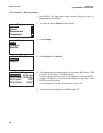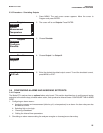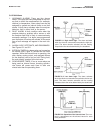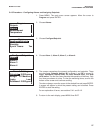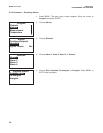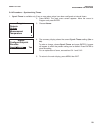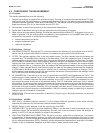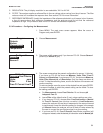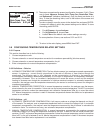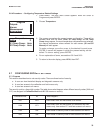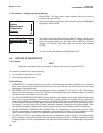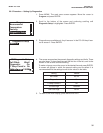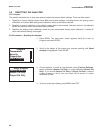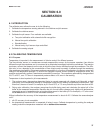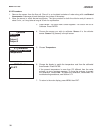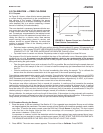
MODEL FCL-1056 SECTION 5.0
PROGRAMMING THE ANALYZER
5.6 CONFIGURING TEMPERATURE RELATED SETTINGS
5.6.1 Purpose
This section describes how to do the following:
1. Choose temperature units.
2. Choose automatic or manual temperature correction for membrane permeability (chlorine sensor).
3. Choose automatic or manual temperature compensation for pH.
4. Enter a temperature for manual temperature compensation.
5.6.2 Definitions - Chlorine
1. AUTOMATIC TEMPERATURE CORRECTION. The free chlorine sensor is a membrane-covered amperometric
sensor. It produces a current directly proportional to the rate of diffusion of free chlorine through the
membrane. The diffusion rate, in turn, depends on the concentration of chlorine in the sample and
the membrane permeability. Membrane permeability is a function of temperature. As temperature increases,
permeability increases. Thus, an increase in temperature will cause the sensor current and the analyzer
reading to increase even though the concentration of chlorine remained constant. In automatic temperature
correction, the analyzer uses the temperature measured by the sensor to continuously correct for changes in
membrane permeability.
2. MANUAL TEMPERATURE CORRECTION. In manual temperature correction, the analyzer uses the temper-
ature entered by the user for correction. It does not use the actual process temperature. Do NOT use manual
temperature correction unless the measurement and calibration temperatures differ by no more than about
2ºC. Manual temperature correction is useful if the sensor temperature element has failed and a replacement
sensor is not available.
5.6.3 Definitions – pH
1. AUTOMATIC TEMPERATURE COMPENSATION. A pH sensor produces a voltage that depends on the pH
of the sample. The analyzer uses a temperature-dependent factor to convert the voltage to pH. In automatic
temperature compensation, the analyzer uses the temperature measured by the pH sensor to calculate the
conversion factor. For maximum accuracy, use automatic temperature compensation.
2. MANUAL TEMPERATURE COMPENSATION. In manual temperature compensation the analyzer converts
measured voltage to pH using the temperature entered by the user. It does not use the actual process tem-
perature. Do NOT use manual temperature compensation unless the process temperature varies no more than
about ±2ºC or the pH is between 6 and 8. Manual temperature compensation is useful if the sensor tempera-
ture element has failed and a replacement is not available.
32
5. The screen summarizes the present configuration for sensor 2 (pH). There
are six items: Measure, Preamp, Sol’n Temp Corr, Resolution, Filter,
and Reference Z (reference impedance). Only four items are shown at a
time. To view the remaining items, scroll to the bottom of the screen and
continue scrolling.
To make a change, move the cursor to the desired line and press ENTER.
A screen will appear in which the present setting can be edited. To store
the setting press ENTER.
a. For pH Preamp, choose Analyzer
b. For pH Reference Z, choose Low.
c. Leave Filter at the default value unless readings are noisy.
For an explanation of terms, see sections 5.5.2 and 5.5.3.
6. To return to the main display, press MENU then EXIT.
S2 Configure
Measure: pH
Preamp: Analyzer
Soln Temp Corr: Off
Resolution: 0.01 pH
Measure:



